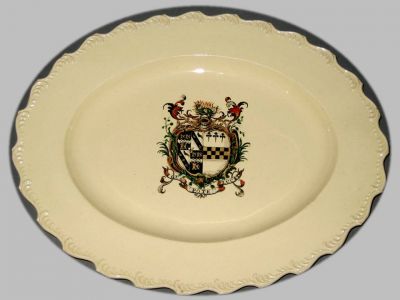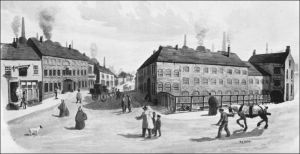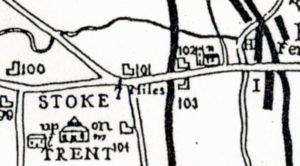- History
- Pottery
- Industry
Josiah Spode I: Early Partnerships
|
Spode had left Banks and rented his own small potworks in 1767, where he worked in partnership with William Tomlinson. Thomas Whieldon, Spode's former mentor, co-signed their partnership agreement. Tomlinson and Spode set up in the Bridge Bank Works in Stoke-upon-Trent. A 1771 invoice to Josiah and Tomas Wedgwood for flat plates, soup plates and "Long feathered dishes" records the early years of the Spode-Tomlinson partnership. Wedgwood's purchase suggests that Spode-Tomlinson's early products were feather-edge creamware. Partnerships normally lasted seven years. In 1772, two years before Josiah Spode’s agreement with Tomlinson expired, Spode entered into an additional seven year partnership with Thomas Mountford. Mountford was from a wealthy local family and wanted a competent potter to teach him the “art and mystery of the trade.” Their potworks was in Shelton on the road from Stoke-upon-Trent to Hanley, Burslem, and Tunstall. Josiah Spode II and Samuel, Josiah Spode’s two sons, followed him into the business. They likely joined him and William Tomlinson at the Bridge Banks Works in Stoke. There, as the sons of one of the partners, they would have been expected to learn all aspects of the potting business and may have enjoyed privileged positions as they grew more proficient. On entering into his partnership with Mountford, Josiah continued his existing partnership with Tomlinson for the remaining two years of their agreement. As part of that agreement he was not to pursue any additional business that might have been considered a conflict of interest. At the end of his partnership with Tomlinson, Spode continued to rent the potworks until Lady Day, March 25, 1775. Presumably his sons were the working managers and no doubt they returned home with reports of daily business and sought their father’s guidance. Josiah Spode must have longed to be an independent potter and to purchase, rather than to rent, his own premises. His chance came when his old employer William Banks ceased business and his pottery became available. |
 “Long feathered dish” of the kind Spode might have supplied to John and Thomas Wedgwood. This example painted with a coat of arms. Winterthur Museum Gift of Mr. & Mrs. Bruce Coleman Perkins 2008.55.2  View of Stoke-upon-Trent with Bridge Bank works on the right, early 19th century |

 After leaving Whieldon's employ, Josiah Spode seems to have found a more lucrative position. His purchase of a house and land in 1758 suggests a degree of prosperity. Perhaps he went directly to work in the pottery of William Banks. Ironically, it was the Banks pottery that eventually became the great Spode works. In 1759 Banks, in partnership with John Turner, purchased a small
After leaving Whieldon's employ, Josiah Spode seems to have found a more lucrative position. His purchase of a house and land in 1758 suggests a degree of prosperity. Perhaps he went directly to work in the pottery of William Banks. Ironically, it was the Banks pottery that eventually became the great Spode works. In 1759 Banks, in partnership with John Turner, purchased a small

